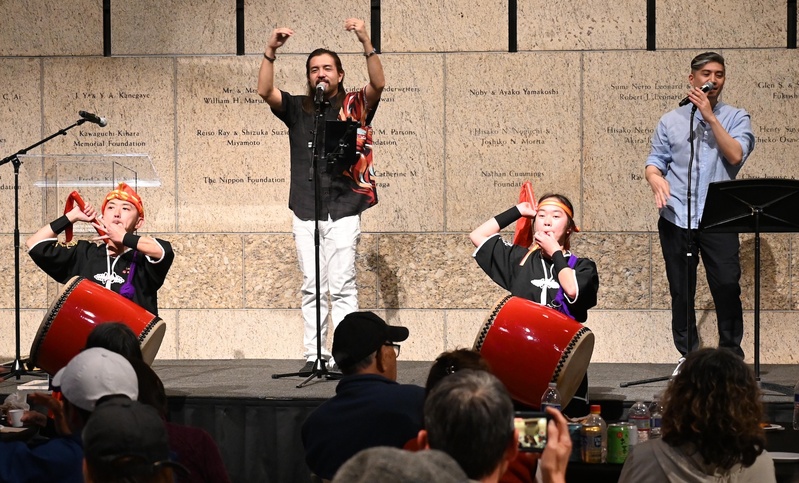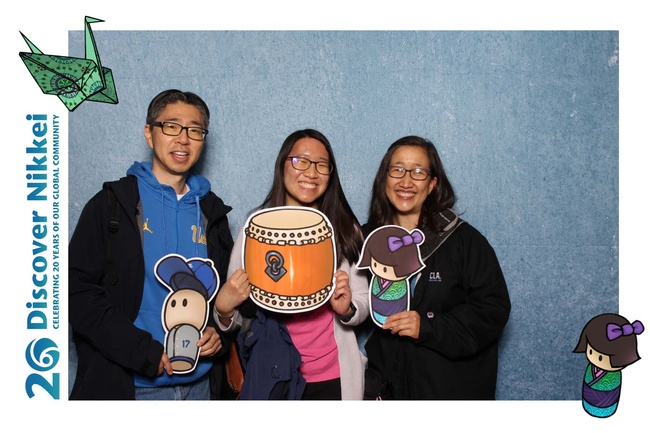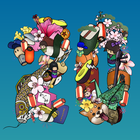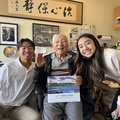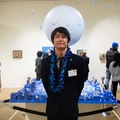Rows of colorful tents stretched along the pathway, fabric lanterns bobbing as people flitted among booth stalls, heads bent in laughter and conversation. Smiles of all ages greeted me, excitedly welcoming me to Discover Nikkei Fest, a huge celebration held on February 8, 2025, at the Japanese American National Museum (JANM) to launch a year-long commemoration of Discover Nikkei’s 20th anniversary. “It’s here,” I told my parents as I stepped into the JANM plaza in Little Tokyo. Shading my eyes, I took in the sight before me, watching as children chased each other between the booths, their laughter gliding over the rumble of LA traffic. Feeling as if the event was a living, breathing representation of Discover Nikkei’s spirit to acknowledge diverse Nikkei culture around the world, I smiled as I watched so many different people come together to celebrate and remember each other in this beautiful community space.
Community Fair
“Discover Nikkei Fest,” the first sign on the left read. I snapped a quick photo of the two black-framed signs, taking note of the event’s itinerary and the generous sponsors who have supported our project. Behind me, I could feel curious glances from the Japanese Village Plaza as people chattered about the excited crowds and lively music booming from the steps of JANM. At the check-in booth, I was greeted warmly and handed a program with a stamp sheet printed on the back for Discover Nikkei’s stamp rally. Prepared to collect cultural stamps and win a fun prize, I headed toward my first booth, the Go For Broke National Education Center (GFBNEC).
“What does your organization do?” I asked the friendly volunteer working the booth. I learned that GFBNEC seeks to fight for equality in remembrance of Nisei soldiers who risked their lives during World War II. The exhibition, which remembers such an important part of Japanese American history, is located at the heart of Little Tokyo next to JANM. As I left the GFBNEC booth, my feet took a quick detour to shop for merchandise from the Giant Robot Store. A few minutes later, I walked happily on my way through the community stalls toward my first workshop, my backpack weighed down by a cute, forest-green pocket notebook.
Family Stories Workshops
A little lost, I paused outside the closed wooden doors in the Democracy Center. “Are you here for the workshop?” a kind woman greeted me.
“Yes,” I replied, surprised, turning to face her.
“Audrey,” she tapped hurriedly on her daughter’s shoulder, indicating in my direction. I then had the privilege of meeting Audrey Shiono, co-founder of Let’s Talk Story Club, a nonprofit organization founded by her and her brother Taisho to preserve seniors’ memories through the Let’s Talk Story book. The book contains insightful prompts to inspire meaningful conversations with seniors, promoting cognitive function while battling senior isolation.
“You need seniors, that’s us!” Two good-natured men walked up to the waiting area excitedly where they met Audrey and began asking her about her nonprofit. In a couple of minutes, the workshop doors opened, and we began filing into the spacious room.
“Hi! My name is Kayla,” I introduced myself, smiling hesitantly as I took a seat next to an easygoing lady already seated at one of the tables. She immediately welcomed me with friendly conversation, and we became a pair for the workshop as Audrey began handing out Let’s Talk Story books to spark the process of sharing stories.
The workshop soon passed in a blur. Although we only got through the first five pages of the book, I appreciated learning about my partner’s family immigration history and connecting with her through our the similarities and differences in our histories. I had initially thought of Let’s Talk Story Club as a volunteer service for youth to provide companionship to seniors, but I realized it is also an opportunity for youth to appreciate the lived histories of others. I found it humanizing how this community workshop brought a kind, outgoing senior and a shy college student together through the practice of sharing memories.
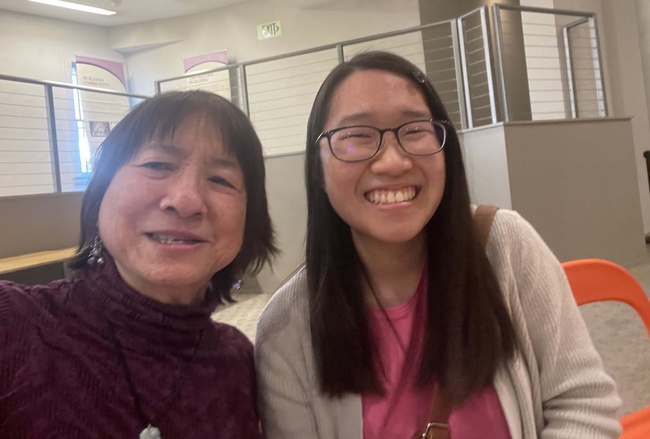
As the Let’s Talk Story Club Workshop ended, I headed over to the Tateuchi Democracy Forum to attend the Video Life History Interviews Workshop. I greeted the two easygoing friends I saw earlier outside the Let’s Talk Story Club workshop and took a seat next to them.
“You want the speaker’s background to be reflective of their personality,” the presenter, Evan Kodani of JANM’s Watase Media Arts Center, began to explain. The suggestion was a testament to the detailed precision and careful attention that go into documentary filmmaking. Besides the actual content of the interview, which I usually focus on, I began to realize there is also significance embedded into place. In the span of an hour, I learned multiple film techniques regarding lighting, composition, and sound equipment to achieve a more professional video quality. Most importantly, the workshop helped me appreciate the power of film to capture and convey important histories.
Community Fair, Part 2
Attempting to catch the last of the community fair booths, I rushed outside the Democracy Center and stopped next to Okaeri’s booth. The volunteers kindly educated me about Okaeri’s mission to create visibility and open spaces for Nikkei LGBTQ+ and their families. The organization also recently published the book Letters to Home: Art and Writing by LGBTQ+ Nikkei and Allies, an eye-opening anthology whose book talk I would later attend.
“What does your identity mean to you?” I stopped to take in the sight of countless paper squares flapping in the wind, answers attempting to escape the cardboard tack board and enter the observer’s mind. Next to the board was the Discover Nikkei booth with pens and sheets of paper for community members to fill out their responses to the reflective prompt. Leaning closer, I noticed the beautiful interweaving of drawings and sentences from people of all ages, creating a tapestry of cultural meaning on a single board. Seeing the visible reflections of both the differences between Nikkei experiences while acknowledging an underlying community, I never felt prouder to call this community home.
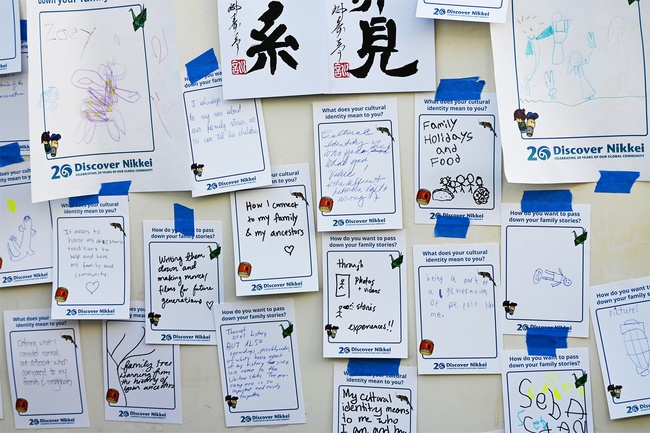
Sharing International Nikkei Family Stories Panel Discussion
“Is this the line for the event?” A person wearing a cloth mask walked up to me, indicating the line extending outside the doors of the Democracy Center.
“I think so!” I replied. I recognized her as another attendee of the Let’s Talk Story Club workshop, and we began excitedly talking about the upcoming panel discussion until we were ushered inside for the event.
“It’s such an honor for me to introduce to you Yoko Nishimura, who is Discover Nikkei’s project manager,” Ann Burroughs, CEO of JANM, spoke into the microphone. As Nishimura walked up to the podium, I realized how much we owe the existence of this incredible project to her. For twenty years, she and the Discover Nikkei staff team have carried out the project’s mission by collecting international and intergenerational stories. As a volunteer writer, I was filled with gratitude for the tremendous dedication of Discover Nikkei’s organizers, staff, sponsors, volunteers, and community of people who have always believed in this project.
“Joining us from the world … Brazil, Peru, Canada, Australia, Argentina, even Cuba, Hong Kong, Puerto Rico, and so many places,” Nishimura announced, highlighting the astounding international reach of the panel discussion. Moderated by Naomi Hirahara, the next hours spun a tapestry of transnational stories interweaving threads of Nikkei identity as shared by Andrew Hasegawa (Australia), Gus Hokama (Argentina), Mitch Homma (United States), Harumi López Higa (Peru), and Jorge Okubaro (Brazil).
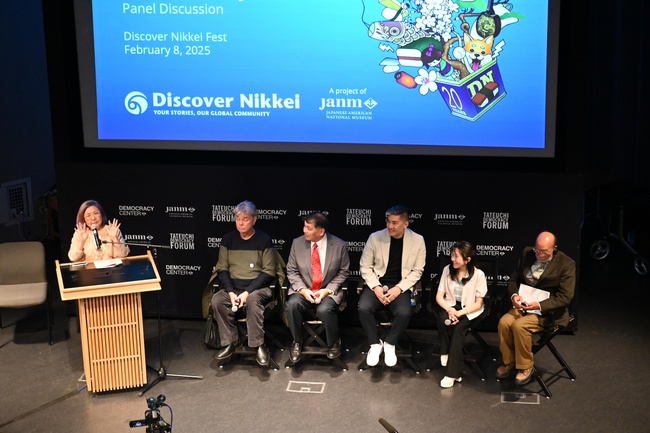
Listening to each panelist’s story, I became aware that the Nikkei community has never contained a singular narrative, but rather a compilation of diverse narratives held together through collective cultural memory. Through Hasegawa’s narration of Japanese incarceration in Australia and later Homma’s similarly painful recollection of incarceration in the United States, I recognized how the injustices of incarceration during WWII were not isolated, but rather transnational events. At the same time, I listened to Okubaro’s discussion of Brazil’s Shindo Renmei (“League of the Path of Subjects”) period when 23 people were murdered, 147 were injured, and many Japanese Brazilians were detained by the police. By learning about these dark histories regarding Nikkei experiences around the world in response to WWII, I realized how important it is to expand my conceptualization of Nikkei history beyond the borders of the country I live in and to recognize the trauma experienced internationally.
Another key theme I learned was the ways in which emotion, even across oceans and borders, continued to resonate within me. Hokama, a talented singer-songwriter who later performed at the reception, described the sacrifice and difficulty his grandparents endured when immigrating to Argentina and their hard work as flower growers. As I considered what my own grandparents sacrificed to immigrate to the US, I gained a greater appreciation for the diversity and connection between migration histories. At the same time, López Higa highlighted her experiences of loss, healing, and hope through lyrical metaphors of puzzle pieces and her moving short film that explored identity through an intergenerational lens. Spanning fields of social activism, film, music, and historiography, the panel discussion highlighted the ways in which Nikkei have carved out spaces for themselves while remaining connected to their culture.
Reception
As the panel discussion ended, waves of attendees began making their way down the stairs toward the promise of delicious food. Following in their wake, I exited the Democracy Center into the chilly night air where I met up with my parents outside JANM.
“Let’s go inside!” I told them excitedly, entering through the open door. My eyes immediately widened in awe as I took in the sight before me, catching on buffet platters of food lined up on the far side of the spacious room and the community of people seated at banquet tables. Lining up for the photo booth, I rushed over to the props table, falling in love with the adorable cutouts. I claimed the taiko drum; my dad, a huge Dodger fan, took the chibi Ohtani cutout; and my mom held a Japanese doll. CLICK! The photos rolled out of the printer.
To conclude the festival, the night ended with amazing live music performances from Gus Hokama, John Azama, and the Ryukyukoku Matsuri Daiko LA taiko drumming performers. Whether hearing Hokama’s moving songs about his family migration or the loud whistles and shouts of the taiko drummers beating in tandem with my heart, I was filled with an immense pride for the community that I call my home. “Okinawan music is really soulful,” I remember overhearing someone say near me, and at this moment I truly understood what they meant. Every beat of the taiko drum reverberated as a musical homecoming for this room full of audience members who swayed to a rhythm of culture. As I clapped furiously, I realized that music, a language I have always believed has no borders carved into it, brought together this Nikkei community in celebration.
What’s Next? The 20 for 20 Campaign!
Discover Nikkei Fest was an incredible celebration of the hard work dedicated to supporting our ever-growing project and an exciting start to the project’s 20 for 20 Campaign. The stories shared by Discover Nikkei have only been possible because of the people who have believed in the project. As we continue to expand our program throughout this year, I hope that you will consider joining us and supporting our project by donating to our 20 for 20 Campaign. As a volunteer writer, it is an incredible honor to listen to and share other Nikkei stories and one of the greatest gifts to be a part of this beautiful community.
* * * * *
Watch the full panel discussion, musical performances, and festival highlights on Discover Nikkei’s YouTube channel. Make a donation to the 20 for 20 Campaign here, and find out about upcoming 20th anniversary programs here.
© 2025 Kayla Kamei


